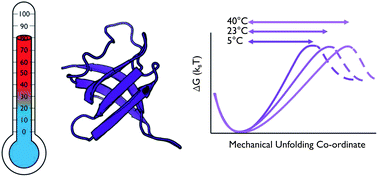Single molecule force spectroscopy reveals the temperature-dependent robustness and malleability of a hyperthermophilic protein†
Abstract
The ability of thermophilic and hyperthermophilic

* Corresponding authors
a
School of Physics and Astronomy, University of Leeds, Leeds LS2 9JT, UK
E-mail:
L.Dougan@leeds.ac.uk
Fax: +44 (0)113 343 3900
Tel: +44 (0)113 343 8958
b Astbury Centre for Structural Molecular Biology, University of Leeds, Leeds LS2 9JT, UK
The ability of thermophilic and hyperthermophilic

 Please wait while we load your content...
Something went wrong. Try again?
Please wait while we load your content...
Something went wrong. Try again?
K. M. Tych, T. Hoffmann, D. J. Brockwell and L. Dougan, Soft Matter, 2013, 9, 9016 DOI: 10.1039/C3SM51439K
To request permission to reproduce material from this article, please go to the Copyright Clearance Center request page.
If you are an author contributing to an RSC publication, you do not need to request permission provided correct acknowledgement is given.
If you are the author of this article, you do not need to request permission to reproduce figures and diagrams provided correct acknowledgement is given. If you want to reproduce the whole article in a third-party publication (excluding your thesis/dissertation for which permission is not required) please go to the Copyright Clearance Center request page.
Read more about how to correctly acknowledge RSC content.
 Fetching data from CrossRef.
Fetching data from CrossRef.
This may take some time to load.
Loading related content
